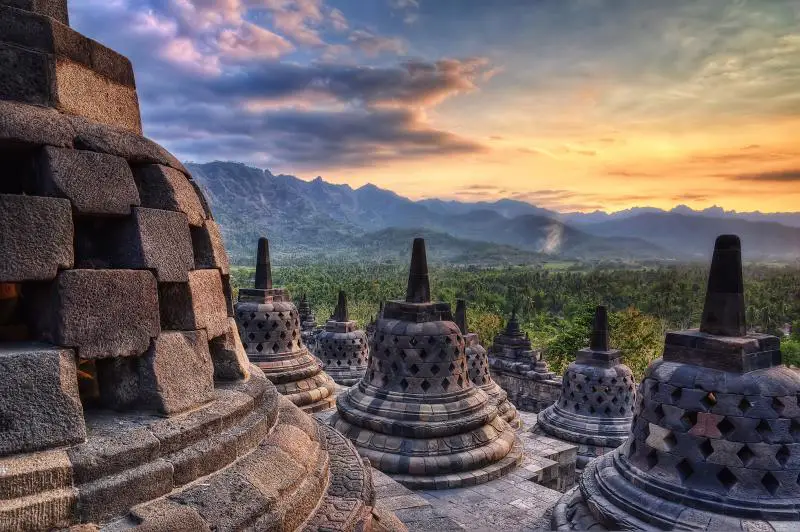Indonesia is one of the most stunning places to visit in Southeast Asia. From the incredible outdoor adventures, historical temples, to the unspoiled landscapes, you’ll have an unforgettable experience visiting Indonesia’s attractions.
If you’re a UNESCO World Heritage Sites chaser, you’re in luck! UNESCO (United Nations Educational, Scientific and Cultural Organization) recognizes 9 World Heritage Sites in Indonesia – 5 cultural and 4 natural sites. Currently, there are 1121 protected properties in the world that meet UNESCO’s selection criteria and provide an incredible value to visitors. Nineteen sites are on the tentative list waiting to be recognized in the future.
Since you may not have heard of all of these places, we’re highlighting the 9 must see UNESCO World Heritage Sites in Indonesia. Each of the sites has information on how to get there and admission costs. Many thanks to our favorite travel influencers who contributed their amazing experiences at the sites.
If you’re looking for more UNESCO posts, check out the UNESCO Creative Cities of Gastronomy to inspire you to visit these top foodie destinations or UNESCO sites in Vietnam.
*Disclaimer: We’re giving you a heads up that this post contains affiliate links. If you click on them and make a purchase, we receive a small commission. There is no additional cost to you. Appreciate the support.
Map of the UNESCO World Heritage Sites in Indonesia
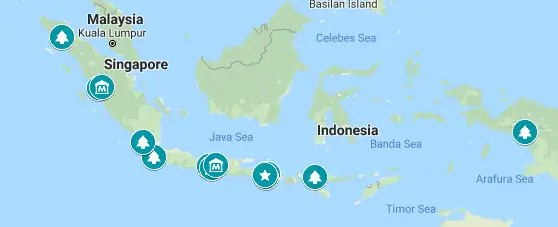
Click on the image to see a map of the UNESCO World Heritage Sites in Indonesia. Credit: Map data: Google
Borobudur Temple Compounds
By Bec, Wyld Family Travel
Borobudur Temple is located outside Yogyakarta in Java, Indonesia. Borobudur has been standing in the jungles of Java since the 9th-century and is the largest Buddhist religious site in the world. The temple consists of nine stacked platforms, six square and three circulars, topped by a central dome.
If you arrive at Borobudur early enough, you may be lucky and get a morning where the fog is still lingering around. This gives Borobudur a mythical appearance.
You walk up a long drive to reach the base of the temple. Every step closer to the temple looms larger on the landscape. The climb to the top is steep but so rewarding once you can gaze out across the landscape.
Every view from every angle of the temple is worthwhile. We spent well over an hour on top just gazing and taking pictures.
A visit in the morning will give you a far better experience as you’ll beat the tour buses. Borobudur was far more striking and satisfying than the more popular Angkor Wat.
UNESCO Recognition Year: 1991
How to Get There: The easiest way to get there is on an organized tour or hire a driver for the day.
Check out these tour options for Borobudur Temple:
- Half Day Tour with Borobudur Sunrise
- Half Day Private Borobudur Tour
- Sunrise on Setumbu Hill
- Full Day Tour with Sunrise & Prambanan Temple
- Full Day Tour with Sunrise, Merapi Volcano, & Prambanan Temple
Admission Cost:
- If taking a tour, the temple cost will be included.
- If visiting the sites on your own: Ages 10+ is $25 USD; Ages 3-10 is $15 USD. If combined with Prambanan Temple: Ages 10+ is $45; Ages 3-10 is $27.
Official Website: http://borobudurpark.com/en/temple/borobudur-2/
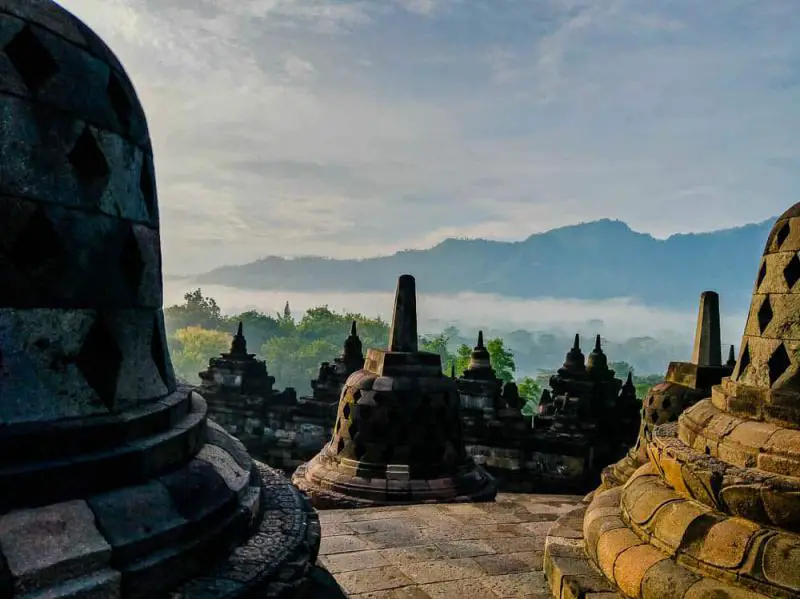
The morning views of the Borobudur Temple is stunning. Photo credit: Wyld Family Travel
Prambanan Temple Compounds
By Mark, Travels in Gippsland
Prambanan is a 9th-century Hindu temple located outside Yogyakarta in Java, Indonesia. The temple is dedicated to the Trimūrti the Hindu god of, the expression ado the Creator, the Preserver, and the Transformer.
Prambanan Temple complex was originally made up of hundreds of temples. Through the centuries many were dismantled by the locals and the stone used to build houses and walls.
You’ll find the story of Ramayana around the three main shrines. You can see the sculptures and the story can be read from the east gate clockwise around the inner compound. Learning about the legend of Prambanan Temple is fascinating as we wandered the huge Indonesian temple complex.
There is more to Prambanan than the main temples as scattered around the site are other temples. With a short walk, you’re rewarded with fewer crowds at these temples. Sewu Temple is 600 meters (.40 miles) from the main temple and was empty on arrival. Like all sites in Indonesia, it’s best to visit early to beat the crowds.
UNESCO Recognition Year: 1991
How to Get There: Prambanan is best reached by bus or car. You can hire a driver or book a journey on Grab rail-hailing app. Another option is to take an organized tour.
Check out these tour options for Prambanan Temple:
- Half Day Private Prambanan Temple Sunset Tour
- Full Day Tour with Borobudur Sunrise & Prambanan Temple
- Full Day Tour with Sunrise, Merapi Volcano, & Prambanan Temple
Admission Cost:
- If taking a tour, the temple cost will be included.
- If visiting the sites on your own, ages 10+ is $25 USD, ages 3-10 is $15 USD. If combined with Prambanan Temple, ages 10+ is $45, ages 3-10 is $27.
Official Website: http://borobudurpark.com/en/temple/prambanan-2/
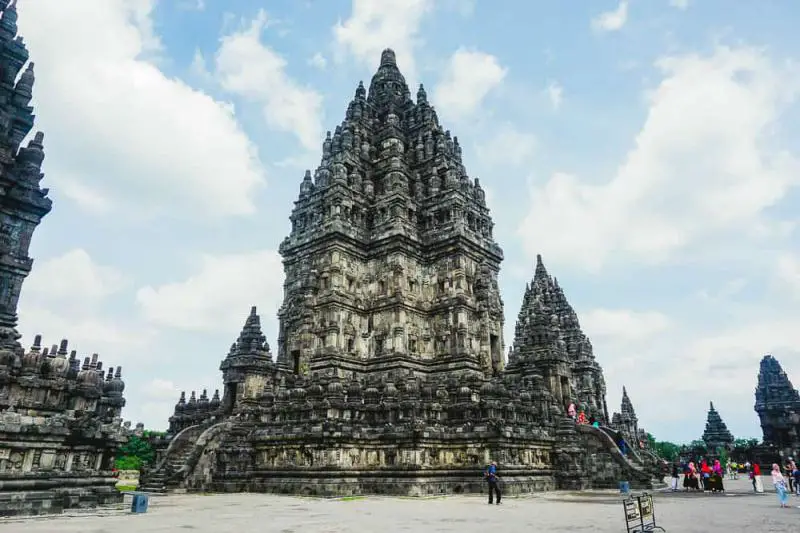
Check out the Prambanan Temple, one of the historical sites to visit in Indonesia. Photo credit: Travels in Gippsland
Tropical Rainforest Heritage of Sumatra
By Becki, Meet Me In Departures
Gunung Leuser National Park, Kerinci Seblat National Park, and Bukit Barisan Selatan National Park comprises of the tropical rainforest in Sumatra. Due to the rainforest expanding across the entire island, we’re focusing specifically on Gunung Leuser.
Gunung Leuser National Park is situated in the north of the island of Sumatra. The gateway to the UNESCO site is a river village called Bukit Lawang. Located on the banks of the Bahorok River, this is where the hub of anything orang-utan trekking happens.
Treks into the rainforests can be arranged directly through the guesthouse owners starting from day visits to multiple nights stays in the National Park. Due to the river running back to the village, most treks end with tubing.
You’ll notice a lot of the surrounding area to Gunung Leuser National Park is surrounded by palm oil plantations. In 1973, two Swiss Zoologists set up The Bukit Lawang Rehabilitation Centre for Orang-utans to take care of orang-utans displaced, injured and orphaned by deforestation.
Although you won’t ever be 100% guaranteed to see an orang-utan, the chances of spotting them are relatively high, particularly the rehabilitated orang-utans due to their association with humans and food (please do not feed them!)
It’s trickier to spot the fully wild orang-utans as they’ll avoid human contact. You might catch a glimpse of orange fur in the tree if you’re lucky. There is also a multitude of other native primates, birds, lizards, insects, and fauna to keep any wildlife-buff interested.
UNESCO Recognition Year: 2004
How to Get There: The nearest airport to the Gunung Leuser National Park is in Medan. The two main ways to make the 88 kilometers (55 miles) journey to Bukit Lawang is by public bus or private car. The bus will take the best part of the day with several changes (and long waits if you miss your connection). The taxi takes anywhere between 3-6 hours depending on how bad Medan traffic is. The roads outside of the city aren’t great either, so expect a bumpy ride!
Admission Cost: The tour prices at the time of visiting were given in Euros, this is due to the majority of visitors to this destination being from Europe. You could opt to pay in local currency. A 2 days/1 night trip, including equipment, food, and guide is 90 Euro ($100 USD) + tip.

Walk across the suspension bridge to head to the Bukit Lewang and organize a tour to see the orang-utans. Photo credit: Meet Me In Departures
Komodo National Park
Komodo National Park is an incredible place to visit for your outdoor adventures. The area consists of three large islands, Komodo, Rinca, and Padar, and 26 smaller surrounding islands.
The top highlights include snorkeling and diving in the beautiful waters, hiking to the peak of Padar Island for the picturesque views of the turquoise bays, relaxing on pink beaches, and seeing the celebrities on the islands, Komodo dragons. It’s no wonder many tourists head to Komodo National Park as a day trip or for 2+ days.
If observing the carnivorous Komodo dragons is high on your must-do list, then visit Komodo and/or Rinca Islands. Both islands provide the opportunity to see the Komodo dragons up close and personal. As the largest lizards in the world, they can grow up to 3 meters (10 feet) in length. For security, all visitors need to have a National Park guide and to take a tour.
On Rinca Island, there is a higher chance of seeing the Komodo dragons as the island is smaller and more concentrated. The younger ones are adorable as they hang out in the trees. The large ones are indeed intimidating as they walk with their tongues flicking out to smell food. Otherwise, it’s a safe experience as the guides direct them to another route if they get too close to the visitors.
UNESCO Recognition Year: 1991
How to Get There: Take a flight to Labuan Bajo island. Once you land, head to the main downtown area of Labuan Bajo to hire an organized tour group to take you to Komodo National Park. You’ll travel either on a local wooden boat, speedboat, or yacht depending on your budget.
Here are some tour options for Komodo National Park:
- 2 Days Private Tour with Boat Stay
- 3 Days Private Tour with Boat and Hotel Stay
- 4 Days Private Tour with Boat and Hotel Stay
Admission Cost: Tour costs vary depending on the number of days and your budget. The admission cost to the National Park is different if you visit on a weekday starting at 150,000 IDR ($10 USD) or a weekend starting at 315,000 IDR ($21 USD). Additional fees may be added to the cost.
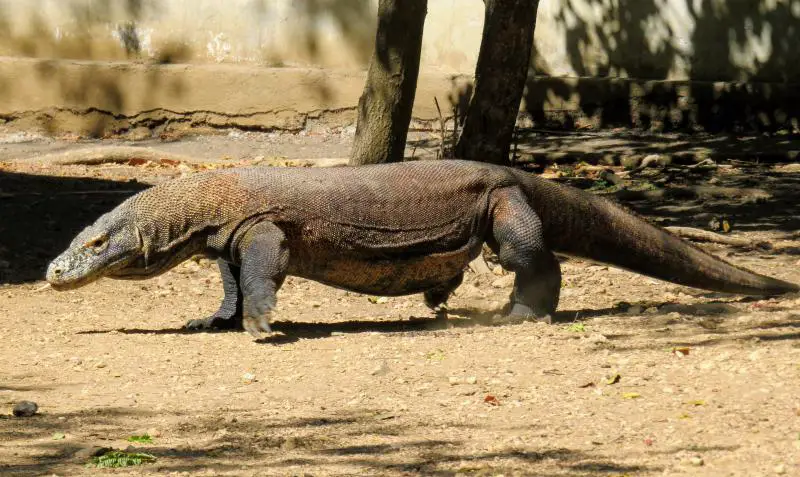
You can’t miss seeing the Komodo dragons while you’re at Komodo National Park!
Cultural Landscape of Bali Province: the Subak System as a Manifestation of the Tri Hita Karana Philosophy
Rice is an integral component of Balinese cuisine. As you explore Bali, you’ll notice the beautiful cascading rice terraces along the side of the roads. It takes an efficient water system to keep the luscious rice terraces green, thus, the UNESCO’s recognition of the subak, a water irrigation system of canals and tunnels connects at over 19,500 hectares.
Five main rice terraces and their associated water temples are connected with the subak, which then get passed to the other fields on the island. The subak is based on the Tri Hita Karana philosophy, which brings harmony with God, people, and the environment. Farmers have used this system for a thousand years which is why there has been good fortune with the rice crops over the years.
While you can’t see the subak system itself, check out the important water temples and rice fields during your Bali itinerary. Pura Ulun Danu Batur and Pura Taman Ayun (royal water temple) are the highlights for the water temples.
Also, check out one of the famous Jatiluwih rice terraces. Follow the walking paths to talk with locals to learn more about the fields and the history of the area. If you have the timing right, the terraced rice fields is rich in greenery across the landscape. Otherwise, the rice fields are yellow and smoky as the dried plants are burned for the next season.
UNESCO Recognition Year: 2012
How to Get There: You can travel to the main areas via a motorbike, hire a driver, or go through an organized day tour.
Check out the tour options to see the World Heritage Sites:
- UNESCO Day Tour: Bedugul, Jatiluwih Rice Terrace, and Tanah Lot
- UNESCO World Heritage Sites Small Group Tour
- Jatiluwih Rice Terrace on an Electric Bike
Admission Cost: The cost to the temples and the rice fields vary. Jatiluwih rice fields cost 40,000 IDR ($2.70 USD).
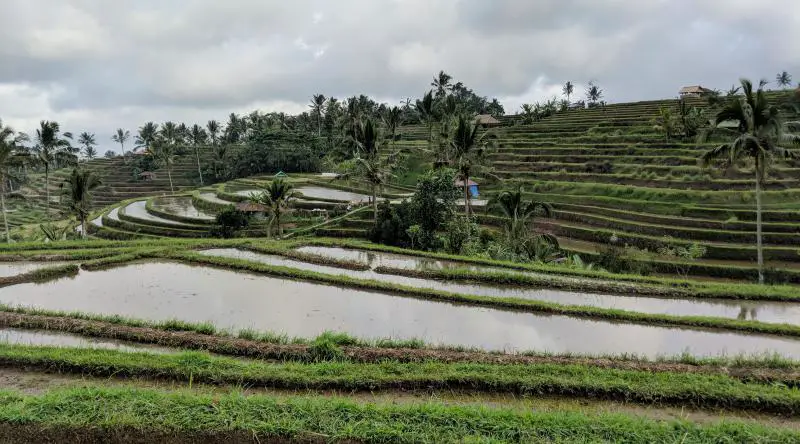
Jatiluwih rice terrace is one of the top UNESCO World Heritage sites to visit in Bali.
Read our other Bali posts to help with your travel planning:
Lorentz National Park
Visiting Lorentz National Park is high on the bucket list even though it’s challenging to get to. Located on Papau island, this remote National Park is the largest protected park area at 2.35 million hectares in Southeast Asia.
It’s a nature lovers’ dream with the unspoiled landscapes of glaciers, cascading mountains, and wildlife with over 600 bird and 120 mammal species here.
A challenging adventure includes climbing the Carstensz Pyramid (Puncak Jaya) to reach the highest mountain in Indonesia at an astounding 4884 meters (16,023 feet). Carstensz Pyramid is one of the Seven Summits depending on which summit guidelines you’re following so it’s on the same scale as Mount Kilimanjaro. Prepare for the altitude and distance with prior training.
UNESCO Recognition Year: 1999
How to Get There: Flying to Wamena and Timika are recommended. It’s also recommended to have an organized tour, especially if you plan to visit the Carstensz Pyramid.
Admission Cost: Visitors need to get a permit to enter the National Park from the Forestry Conservation Office in Wamena. Tour agencies can help procure the permit.
Sangiran Early Man Site
The Sangiran Early Man Site is an important archeological site in Central Java. It’s famous for the discovery of the first hominid fossils, other homo erectus fossils, and stone tools in the 1930s.
While the excavation site is protected, you can visit the Sangiran Museum. Learn about human evolution and even get the chance to see fossils (albeit they are replicas). It’s a great learning opportunity for children and families to experience.
UNESCO Recognition Year: 1996
How to Get There: It’s recommended to go to the museum by car or via local buses.
Admission Cost: Starting at 11,500 IDR ($.80 USD) for tourists.
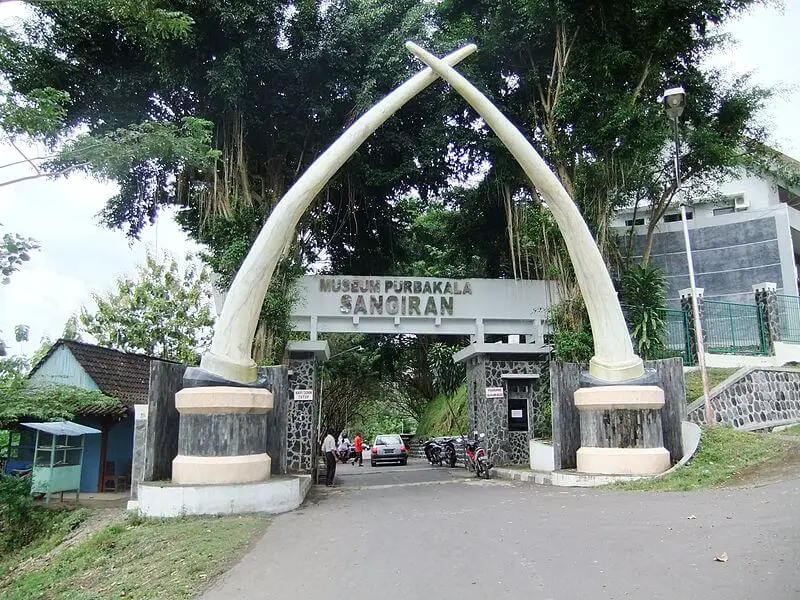
Photo credit: Midori via Wikimedia Creative Commons. Title: Sangiran Museum, Sragen, Indonesia. Click on the photo to see the CC by 3.0 license (https://creativecommons.org/licenses/by/3.0/deed.en)
Ujung Kulon National Park
Ujung Kulon National Park received its UNESCO status as it’s the largest lowland rainforest in Java. The National Park is a collection of volcanic islands including smaller islands with the Krakatoa natural reserve and Panaitan Island.
What makes this National Park special is the incredible biodiversity with the diverse plants and wildlife. It’s home to over 270 species of birds and the endangered species of the Javan rhinoceros.
If you prefer adventurous activities, check out the camping and hiking opportunities as you navigate through the rainforest. Those who prefer spending their time in the crystal blue water can go snorkeling or surfing at the nearby Panaitan Island.
UNESCO Recognition Year: 1991
How to Get There: It’s recommended to hire a driver or you can take local buses to Samur or Taman Jaya, the city before the National Park. You can also find an organized tour agency while you’re in Taman Jaya for your trip to the park.
Admission Cost: Your tour agency will cover the cost of the National Park fees as they start at 25,000 IDR ($1.80 USD) depending on the activities.
Ombilin Coal Mining Heritage of Sawahlunto
As the newest UNESCO Indonesia site, the Ombilin Coal Mining is located in Sawahlunto, West Sumatra. It’s currently the oldest coal mine in Southeast Asia. The Dutch started coal production in 1892 and used both local people and prisoners from Dutch controlled areas as laborers. The area developed as the main mining site for trade and export and included a new railway to transport the coal.
Currently, you can visit the Ombilin Coal Mining Museum to learn about the company’s history and view the tools used in the mines. Visitors have a chance to see the former mining site where original buildings still stand such as the Mbah Soero tunnel, housing for the workers, government buildings, etc.
Definitely add this place to your Indonesia itinerary if you’re interested in mining history.
UNESCO Recognition Year: 2019
How to Get There: From the capital, Pedang, it’s over 90 kilometers (56 miles) away which will take 3 hours by car due to the hills. It’s recommended to hire a driver who can take you here.
Admission Cost: There is an admission fee to see the former mining site starting at 30,000 IDR ($2.15 USD).
We hope you’ll consider visiting one or more of these UNESCO cultural and historical sites in Indonesia. These attractions and sights will provide long-lasting memories from your Indonesian travels.
Which of these UNESCO World Heritage Sites in Indonesia are on your bucket list? Share in the comments below.
Love this post? Save it to your Indonesia board on Pinterest.
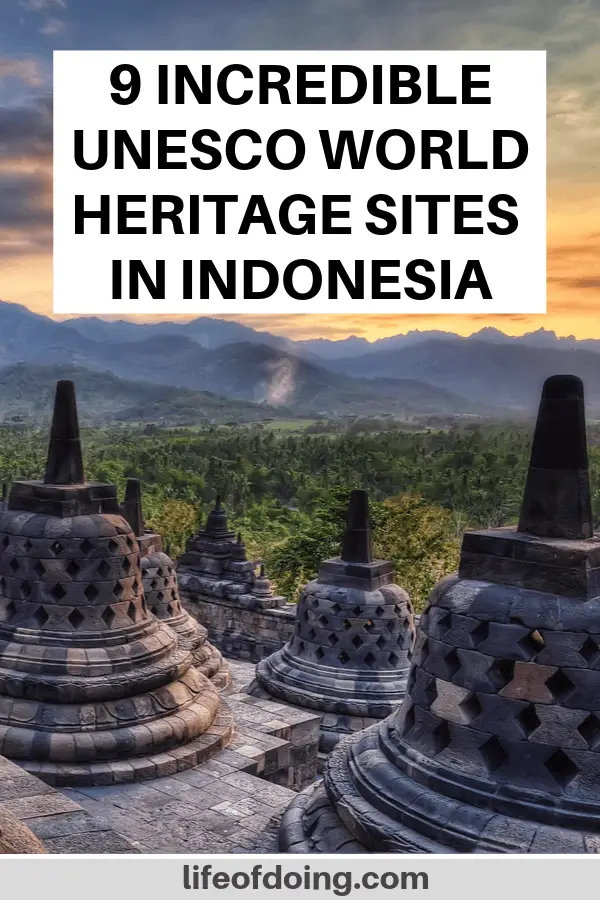 |
Featured and pin #1 photo credit: weissdergeier via Depositphotos

